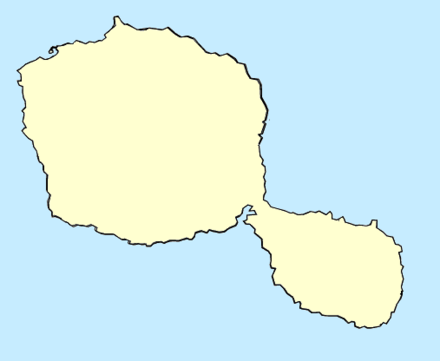2015–16 Tahiti Ligue 1
The 2015–16 Tahiti Ligue 1 is the 69th season of top-flight football in Tahiti.[1] Tefana are the defending champions having won their fourth title last season.
| Season | 2015–16 |
|---|---|
← 2014–15 2016–17 → | |
Teams
A total of eight sides will compete in the 2015–16 campaign. The top side will qualify for a place in the 2017 OFC Champions League, while the bottom two will be relegated to Tahiti Ligue 2.
| Team | Stadium | Location | Capacity | Manager |
|---|---|---|---|---|
| Aorai | Stade De Taunoa | Papeete | 1,000 | |
| Central Sport | Stade Pater Te Hono Nui | Pirae | 15,000 | |
| Dragon | Stade Vélodrome Dr. Pierre Cassiau | Papeete | 5,000 | Ludovic Graugnard |
| Manu-Ura | Stade Paea | Paea | 10,000 | Pita Teivitau |
| Pirae | Stade Vélodrome Dr. Pierre Cassiau | Papeete | 5,000 | Samuel Garcia |
| Taiarapu | Stade Teahupo'o | Teahupo'o | 1,200 | |
| Tefana | Stade Louis Ganivet | Faaa | 5,000 | Sébastien Labayen |
| Vénus | Stade Pater Te Hono Nui | Pirae | 15,000 |
League table
| Pos | Team | Pld | W | D | L | GF | GA | GD | BP | Pts | Qualification or relegation |
|---|---|---|---|---|---|---|---|---|---|---|---|
| 1 | Tefana (C) | 21 | 19 | 2 | 0 | 103 | 20 | +83 | 4 | 84 | Qualified to the 2017 OFC Champions League |
| 2 | Central Sport | 21 | 11 | 1 | 9 | 48 | 51 | −3 | 10 | 65 | |
| 3 | Vénus | 21 | 9 | 6 | 6 | 45 | 42 | +3 | 8 | 62 | Qualified to the Championship Playoff |
| 4 | Pirae | 21 | 10 | 1 | 10 | 58 | 62 | −4 | 10 | 62 | |
| 5 | Manu-Ura | 21 | 11 | 3 | 7 | 48 | 48 | 0 | 2 | 59 | |
| 6 | Dragon | 21 | 4 | 7 | 10 | 41 | 53 | −12 | 6 | 46 | |
| 7 | Taiarapu (R) | 21 | 3 | 4 | 14 | 39 | 68 | −29 | 10 | 44 | Relegation to Tahiti Ligue 2 |
| 8 | Aorai (R) | 21 | 3 | 4 | 14 | 23 | 61 | −38 | 2 | 36 |
Updated to match(es) played on 21 March 2016. Source: RSSSF
Rules for classification: 1) points; 2) goal difference; 3) number of goals scored. 4 points for a win, 2 points for a draw, 1 point for a defeat.
(C) Champion; (R) Relegated.
Rules for classification: 1) points; 2) goal difference; 3) number of goals scored. 4 points for a win, 2 points for a draw, 1 point for a defeat.
(C) Champion; (R) Relegated.
Championship playoff
Bracket
| Semi-finals | Final | |||||
| 28 March | ||||||
| Tefana | 6 | |||||
| 23 April | ||||||
| Pirae | 1 | |||||
| Tefana (p) | 1 (6) | |||||
| 28 March | ||||||
| Central Sport | 1 (5) | |||||
| Central Sport | 4 | |||||
| Vénus | 0 | |||||
gollark: Are you good at biology?
gollark: I agree. This would also make electric cars more practical as they could have smaller batteries due to going shorter distances within a city.
gollark: It is surprisingly non-unusably-slow at least for my usecase.
gollark: My thing might end up containing the unfathomable machine learning™ and exact word match approach together, as it doesn't do very well at finding particular keywords as is.
gollark: So similar words, sort of thing? I was investigating using https://sbert.net/ for my own slightly related thing. It's fairly good for search, at least.
This article is issued from Wikipedia. The text is licensed under Creative Commons - Attribution - Sharealike. Additional terms may apply for the media files.
